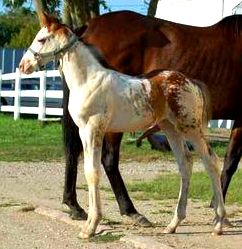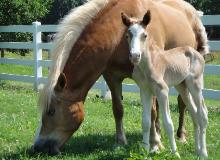What do you think we’ll get? Just bred a solid sorrel paint mare (both parents were sorrel, sire was a paint) to our bay stallion. His sire was a bay and dam was grey. He has thrown all colors. This is our first time breeding the mare, so we have no idea what she throws. Any guesses?
Your only possible options are black, bay, or chestnut/sorrel
chance for a paint? (not that I really want one)…
Most likely no chance if the mare is solid, although occasionally a gene might be there and be very minimally expressed. (Does she have much white at all? Or completely solid?)
She only has a blaze and a hind sock.
eta-she has a flaxen mane and tail. Otherwise, if you didn’t have her papers, you’d never know she was a paint. Stallion normally throws a star, snip, and sock.
What color was the dam before she turned grey? Grey isn’t a color.
[QUOTE=sanctuary;5729339]
chance for a paint? (not that I really want one)…[/QUOTE]
any color but gray…and depends if you are talking overo or tobiano. The overos can “crop up” from solid looking parents in Paints but not tobianos.
As said, without knowing more about each parent, the chances are black, bay, and chestnut.
You might have no chance of one or 2 of those depending on the genetic makeup of a given horse, but odds are you have a chance at all 3, with black being the least likely but still entirely possible.
There’s no chance of a Tobiano.
You do have a chance of multiple overo patterns, particularly Splash and Sabino, coming together to produce something loud but the odds are not great.
Color genetics
I have to look the color stuff up EVERY time… It is so much simpler with humans…
Here are the two sites I find the most helpful:
This site has a color calculator. Sometimes I don’t know enough to fill in the blanks, but it has been helpful:
http://www.horsetesting.com/CCalculator1.asp
I think the site at UC Davis does a great job of explaining it. I have to read it every time I am trying to figure something out but that says more about my brain than their explanation…:
[URL=“http://www.vgl.ucdavis.edu/services/coatcolorhorse.php”]http://www.vgl.ucdavis.edu/services/coatcolorhorse.php
We have a TB tobiano yearling filly I am excited about…have yet to break the news to Sharon White who rides for us though…despite her predilection for orange, her idea of wild color in horses is gray…:lol:
p.s. This is a GREAT conversation to have today because I just saw on Google that it is the birthday of Gregor Mendel - father of genetics!
TB cross maybe, but not TB  Tobiano doesn’t exist in the TB breed
Tobiano doesn’t exist in the TB breed
I find the whole color thing very interesting. Last year we bred a black mare to a black stallion and was blessed with a liver chestnut filly LOADED with bling (full blaze, 4 full stockings). Bred the same black mare to a chestnut stallion and had a black filly this year. Go figure! :eek:
I too have gone to the U C Davis website for a better understanding but the whole color genetics thing is beyond me. :winkgrin: Just glad that they’re healthy! :yes:
I had a homozygous black stallion and a homozygous black mare so there was no possibility of a ‘red’ gene in either. I have found in breeding the homozygous blacks (just my personal experience and not a huge number statistically) that my best chance for a black foal was when I bred homozygous black to chestnut … obviously no chance for chestnut but it also seems there is less chance for bay.
In your case, both mare and stallion in the first breeding have to carry a red gene since the filly was chestnut so although the second stallion was chestnut, the mare simply didn’t pass on her chestnut gene in the second breeding (50/50 odds on that).
TB cross maybe, but not TB Tobiano doesn’t exist in the TB breed
You can see why I have to look it up every time!! :winkgrin:
She is a TB and was listed as a bay overo. Whoops! 

Yep definitely overo 
On the subject of a best chance of black:
Chestnuts can hide Agouti (gene that turns black to bay) and may have 0, 1, or 2 copies. Obviously black x black won’t produce bay, but HZ black x black will always give black
The law of averages says most chestnuts are probably Aa in their Agouti status, but obviously can be AA or aa. HZ black x that aa chestnut will always be black. X the Aa chestnut is a 50/50 shot. X that AA chestnut is always bay.
Homozygous black can be AA.
You are right, sorry, I was talking about a horse who is also black and neglected to get that out LOL
Yep…my perlino QH stallion is HZ black/agouti/cream. Try explaining THAT to someone standing there looking at a pale cream colored horse with blue eyes! Yeeaaaahhhh…uh hu…sure LOOKS like he has two black genes!
Haflingers
I was interested, when doing research on what to expect the year we bred our Haflinger mare to a chestnut and then again this year when we bred her to a black stallion, to find that Haflingers are not true Palominos but are, rather, light or flaxen Chestnuts. Pic of Mom and 1st baby. She is bred to a heterozygous black stallion for next year…

Yep, Haffies are nearly always chestnut - not sure cream even exists.
Bred to a black stallion who is Ee (hetero black), assuming the “heterozygous black stallion” in your equation is black, gives you a 50/50 shot at each of chestnut and black.
JB, aren’t the Haffies sooty or smutty chestnut that look like palomino but aren’t?? I did hear that there is no dilute gene in them even though some of them look palomino.
